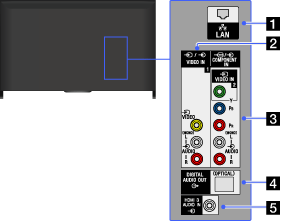- Top Page >
- Parts Description >
- Terminals on the rear (centre)
Terminals on the rear (centre)

 LAN
LAN
Connects to an existing network using an Ethernet cable.
 /
/ VIDEO IN 1
VIDEO IN 1
Connect with a composite video cable. When connecting mono equipment, connect to the L (MONO) audio jack (socket).
 VIDEO IN 2,
VIDEO IN 2,  /
/ COMPONENT IN
COMPONENT IN
This input can be used as a composite video input or as a component video input. When connecting a mono device, connect to the
 L (MONO) audio jack (socket).
L (MONO) audio jack (socket).For a composite connection, use
 VIDEO IN 2 for video signals, and also connect to
VIDEO IN 2 for video signals, and also connect to  (L/R) of
(L/R) of  /
/ COMPONENT IN for audio signals.
COMPONENT IN for audio signals.For a component connection, use Y, PB, PR for video signals, and also connect to
 (L/R) for audio signals.
(L/R) for audio signals.- The TV will automatically detect and switch between
 VIDEO IN 2 and
VIDEO IN 2 and  /
/ COMPONENT IN. To manually set the input type, press the HOME button, then select
COMPONENT IN. To manually set the input type, press the HOME button, then select  [Settings] →
[Settings] →  [External Inputs] → [Video 2/Component Input].
[External Inputs] → [Video 2/Component Input].
- The TV will automatically detect and switch between
- DIGITAL AUDIO OUT (OPTICAL)
You can listen to the TV’s sound on a connected home theatre system with digital audio input (optical).
 HDMI 3 AUDIO IN
HDMI 3 AUDIO IN
This input can be used as an HDMI 3 analogue audio input.
When connecting a device that has a DVI jack (socket), use its analogue audio out jacks (sockets).

